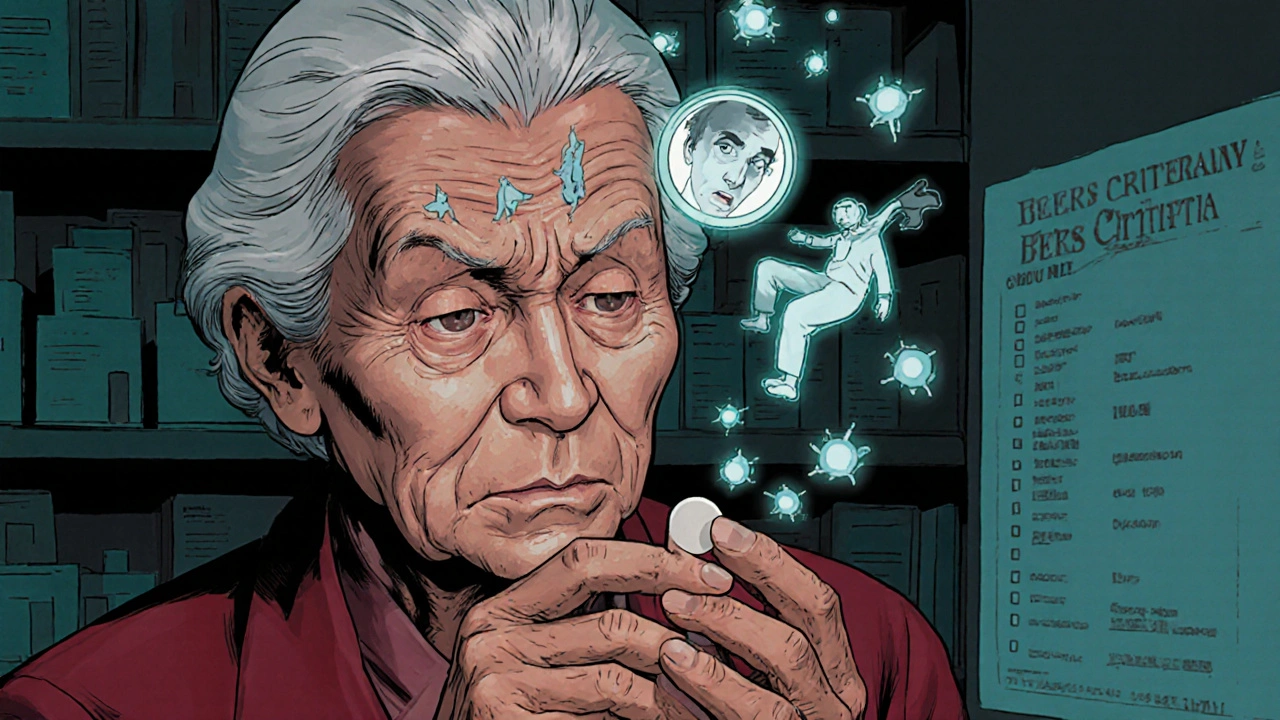By the time you reach 70, your body doesn’t process medicine the same way it did at 30. It’s not just about taking fewer pills-it’s about how your body absorbs, breaks down, and responds to those pills. What once worked perfectly might now cause dizziness, confusion, or even a fall. This isn’t rare. Nearly 90% of adults over 65 take at least one prescription drug every day. And 40% take five or more. That’s a lot of chances for something to go wrong.
Why Your Body Handles Drugs Differently as You Age
Your liver and kidneys don’t work as hard as they used to. That’s not a myth-it’s science. After age 40, your kidneys slowly lose their ability to filter drugs out of your blood. By age 80, you’re clearing some medications 30% to 50% slower than when you were young. Drugs like digoxin, antibiotics, and painkillers stay in your system longer. That means even a normal dose can build up and become toxic.
Your liver, which breaks down many drugs, also slows down. Blood flow to the liver drops by 30% to 40% in older adults. That affects drugs like propranolol and lidocaine, which rely on liver flow to be cleared. Even if your liver cells are healthy, they just don’t get enough blood to do their job efficiently.
Then there’s your body composition. As you age, you lose muscle and gain fat. That changes where drugs go in your body. Fat-soluble drugs like diazepam (Valium) or antidepressants get stored in fat tissue. They’re released slowly, so their effects last longer-sometimes two or three times longer than in younger people. That’s why a small dose can still make you feel groggy the next day.
Less Protein, More Free Drug
Your blood carries many drugs attached to proteins, especially albumin. But as you get older, your body makes less albumin. Serum albumin drops from 4.5 g/dL in your 20s to 3.8 g/dL by age 80. That means more of the drug floats around freely in your bloodstream, unattached. These free drugs are the active ones-the ones that cause effects and side effects.
Take warfarin, for example. It’s highly protein-bound. When albumin drops, even a standard dose can make your blood too thin. That’s why older adults often need 20% to 30% less warfarin than younger people to stay in the safe range. A dose that’s perfect for a 50-year-old could land a 75-year-old in the hospital with internal bleeding.
Stomach Changes Affect How Drugs Are Absorbed
Your stomach doesn’t make as much acid as it used to. That’s normal aging. But it changes how some drugs get absorbed. Drugs like ketoconazole or itraconazole need stomach acid to dissolve. If they don’t dissolve, they don’t work. Other drugs, like acetaminophen, are absorbed slower because your stomach empties 20% to 25% more slowly. That means pain relief takes longer-and you might be tempted to take another pill too soon.
And then there’s the gut itself. The surface area where drugs are absorbed shrinks slightly. Your body just doesn’t grab onto medications the way it used to. That’s why some older adults say, “I took my pill, but I don’t feel anything.” It’s not in their head-it’s in their biology.

Your Brain Gets More Sensitive
One of the most dangerous changes happens in your brain. Older brains are more sensitive to drugs that affect the nervous system. Benzodiazepines like lorazepam or sleep aids like zolpidem can cause severe confusion, memory loss, or falls-even at low doses. Why? Because the blood-brain barrier becomes more permeable, and your brain has fewer nerve cells to buffer the drug’s effects.
Anticholinergic drugs-common in allergy meds, sleep aids, and even some bladder pills-can cause big problems. Diphenhydramine (Benadryl) might help you sleep, but in someone over 75, it raises the risk of confusion by 3 to 5 times. It can also cause urinary retention, especially in men with enlarged prostates. One Reddit user shared: “My 82-year-old mom got confused on 25mg of hydroxyzine. We cut it to 10mg, and she was herself again.” That’s not an anomaly. It’s predictable.
Even your heart changes. Beta-receptors in the heart become less responsive with age. That means drugs like beta-blockers or epinephrine don’t speed up your heart as much. But your blood vessels still respond to alpha-receptors, so blood pressure control stays intact. That’s why some older adults get low blood pressure without a fast heart rate-it’s a mismatch in how the body reacts.
Why Standard Doses Don’t Work Anymore
Most drug dosing is based on studies done in healthy adults under 65. That’s the problem. Only 12% of participants in major drug trials are over 75. So when a pill says “take 10mg daily,” that number was likely tested on a 40-year-old. It’s not wrong-it’s just incomplete.
That’s why doctors are told to “start low, go slow.” For older adults, especially those over 75, starting at 25% to 50% of the standard dose is common. Then, the dose is slowly increased while watching for side effects. This isn’t cautious-it’s necessary.
The American Geriatrics Society’s Beers Criteria lists 30 types of medications that should be avoided or reduced in older adults. These include certain painkillers, antipsychotics, and anticholinergics. Many of these drugs are still prescribed because doctors aren’t trained in geriatric pharmacology. And many patients don’t know to ask.
How to Know If Your Dose Is Right
Don’t rely on your creatinine level alone. That number doesn’t tell the full story. What matters is your creatinine clearance-how well your kidneys are actually filtering. The Cockcroft-Gault equation is the best tool for this. It uses your age, weight, sex, and creatinine to estimate kidney function. If your creatinine clearance is below 60 mL/min, about 40% of common medications need a dose change.
Use tools like the Anticholinergic Cognitive Burden Scale. If you’re taking three or more drugs with anticholinergic effects, your risk of dementia over seven years jumps by 50%. That’s not a small risk. It’s a red flag.
Ask your pharmacist for a med review. Pharmacists are trained to spot these issues. In a 2022 survey, 82% of pharmacists reported better outcomes when they adjusted doses using the “start low, go slow” method.

What’s Being Done to Fix This
The FDA now requires new drugs to include data from adults over 65. Since 2018, 73% of approved drugs have updated dosing for older adults. In 2023, the first age-adjusted dosing algorithm for dabigatran (Pradaxa) was approved. It reduced major bleeding in people over 80 by 31%.
Research is also looking at cellular aging. Senescent cells-old, damaged cells that pile up as we age-release chemicals that interfere with how drugs work. In early studies, removing these cells with drugs like dasatinib and quercetin improved drug response in older tissues. It’s early, but it’s promising.
And there’s growing focus on pharmacogenomics-how your genes interact with aging. Some people naturally break down drugs slower because of gene variations. Those differences become more important as you age. The National Institute on Aging is spending $85 million to study this over the next five years.
What You Can Do Today
Here’s what works:
- Keep a full list of every pill, vitamin, and supplement you take-including over-the-counter ones.
- Ask your doctor: “Is this dose right for my age and kidney function?”
- Ask your pharmacist: “Does this drug have anticholinergic effects?”
- Use the Beers Criteria app to check if your meds are flagged for older adults.
- If you feel foggy, dizzy, or off-balance after starting a new drug, don’t wait-call your doctor.
Medication isn’t the enemy. But treating older adults like younger people is dangerous. The goal isn’t to take fewer drugs-it’s to take the right dose of the right drugs. That’s how you stay safe, independent, and healthy as you age.
Why do older adults need lower doses of medication?
Older adults need lower doses because their bodies process drugs differently. Kidneys and liver work slower, body fat increases, protein levels drop, and the brain becomes more sensitive. These changes mean drugs stay in the body longer and have stronger effects-even at the same dose as a younger person. A standard dose can become toxic.
What are the most dangerous drugs for seniors?
The most dangerous drugs for seniors are those with strong anticholinergic effects (like diphenhydramine), benzodiazepines (like lorazepam), nonsteroidal anti-inflammatories (NSAIDs like ibuprofen), and certain blood thinners (like warfarin) if not properly monitored. These can cause confusion, falls, bleeding, kidney damage, or urinary retention. The Beers Criteria lists 30 drug classes to avoid or adjust in older adults.
How do I know if my kidney function is low enough to adjust my meds?
Don’t rely on your creatinine level alone. Ask for your creatinine clearance using the Cockcroft-Gault equation. This uses your age, weight, sex, and creatinine to estimate kidney function. If your result is below 60 mL/min, many medications need dose reductions. This is especially important for drugs like digoxin, metformin, and antibiotics.
Can over-the-counter meds harm older adults too?
Yes. Many OTC meds are just as risky as prescriptions. Antihistamines like Benadryl, sleep aids with diphenhydramine, and pain relievers like ibuprofen can cause confusion, falls, kidney injury, or bleeding. Even cold and flu mixtures often contain multiple hidden anticholinergics. Always check labels and ask your pharmacist before taking anything new.
What’s the best way to reduce medication risks in older adults?
The best way is to take fewer drugs, use lower doses, and review everything regularly. Ask for a full medication review by a pharmacist or geriatrician at least once a year. Use tools like the Beers Criteria app or the Anticholinergic Burden Calculator. Always start with the lowest possible dose and increase slowly. Never stop or change a drug without talking to your doctor.
What’s Next for Aging and Medication
The future is personal. Researchers are moving away from one-size-fits-all dosing. Instead, they’re building algorithms that factor in age, kidney function, genetics, and even body fat. Platforms like DosemeRx are already being used in hundreds of hospitals to calculate exact doses for each patient.
And there’s hope on the horizon. Drugs that target senescent cells-called senolytics-might one day restore how the body responds to medication. Early trials show they can reduce inflammation and improve drug metabolism in older tissues. It’s not a cure, but it could mean fewer side effects and better control of chronic conditions.
For now, the best defense is awareness. Know your body. Know your meds. Ask questions. And don’t accept a dose just because it’s on the bottle. Your health isn’t one-size-fits-all-and neither should your medication.


Darragh McNulty
November 21, 2025 AT 15:35Wow, this is so important! 🙌 My grandma was on 7 meds and started nodding off like a bobblehead-turned out Benadryl was the culprit. We cut it out and she’s back to her crossword self. 🥳
Willie Doherty
November 22, 2025 AT 00:23The pharmacokinetic alterations associated with advanced age are not merely physiological quirks-they represent a fundamental divergence from the pharmacodynamic models upon which contemporary prescribing paradigms are predicated. The reduction in renal clearance, hepatic perfusion, and plasma protein binding necessitates a reevaluation of the therapeutic index in geriatric populations. Failure to do so constitutes iatrogenic negligence.
David Cusack
November 22, 2025 AT 09:49Let’s be honest-most doctors don’t know what they’re doing. They read a drug insert written for a 30-year-old lab rat and assume it applies to your 80-year-old aunt who’s got three knee replacements and a pacemaker. And don’t even get me started on the FDA…
Elaina Cronin
November 24, 2025 AT 05:14I cannot believe how casually this issue is treated in clinical practice. The systemic failure to adapt dosing protocols for elderly patients is not just negligent-it is morally indefensible. We are prescribing poison under the guise of care, and no one is holding anyone accountable.
Donald Frantz
November 25, 2025 AT 01:23Has anyone looked at how polypharmacy interacts with gut microbiome changes in aging? I’ve seen studies where altered microbiota affect drug metabolism-especially SSRIs and NSAIDs. This might be a hidden variable in why some seniors react so badly to meds that others tolerate fine.
Debanjan Banerjee
November 26, 2025 AT 10:43Excellent breakdown. I work in a hospital pharmacy in Mumbai, and we see this daily. A 78-year-old man on warfarin with INR of 8.2-dose was never adjusted after his creatinine clearance dropped to 45 mL/min. We caught it because we checked Cockcroft-Gault. Never assume. Always calculate.
Steve Harris
November 27, 2025 AT 18:59Thank you for writing this. I’ve been telling my dad for years to get a med review. He’s 76, on 6 meds, and says ‘I’ve been taking them forever.’ But he’s been dizzy since last winter. We’re going to his pharmacist next week. I hope this helps others push for the same.
Michael Marrale
November 28, 2025 AT 21:52Wait… so you’re saying Big Pharma doesn’t test drugs on old people on purpose? That’s not a coincidence. They know if they did, the side effects would be too obvious. They want you hooked on pills you don’t need-so you keep buying. They even make the labels tiny so you can’t read them. It’s all controlled. I saw a documentary about this.
David vaughan
November 30, 2025 AT 07:37Just had my mom’s meds reviewed by her pharmacist-she cut 3 drugs and lowered 2 others. She’s sleeping better, not foggy anymore. The Anticholinergic Burden Calculator flagged 4 meds she was on. I had no idea. This tool is a lifesaver. Link in comments if you want it.
Logan Romine
November 30, 2025 AT 21:50So… we’re just supposed to accept that aging means your body becomes a broken machine that needs constant tinkering? Or is this just capitalism’s way of turning old people into walking prescription pads? We’re not failing biology-we’re failing ethics.
Leo Tamisch
December 2, 2025 AT 05:41Let me guess: the next step is ‘personalized medicine’-a buzzword that means ‘we’ll charge you $5,000 for a genetic test so we can give you the same pill, but slower.’ Meanwhile, your neighbor’s 83-year-old neighbor died from an ibuprofen overdose because ‘it’s OTC.’ So… we’re still doing this wrong.
Daisy L
December 3, 2025 AT 03:53AMERICA NEEDS TO STOP TREATING OUR ELDERLY LIKE EXPIRED MEDS! We don’t throw out grandma because her pills are old-we fix the damn system! These drug companies are laughing all the way to the bank while our parents are falling in the bathroom because of a 10mg dose that was meant for a 40-year-old body. ENOUGH.
Anne Nylander
December 4, 2025 AT 19:04My uncle took a sleeping pill and thought he was in a hotel in Canada. 😵💫 We called the dr. and they said ‘start at 5mg’-he was on 10! Now he’s fine. Just start low, go slow! You got this!
Franck Emma
December 5, 2025 AT 02:29My mom’s on 9 meds. She cried last week because she forgot what her own name was for 20 minutes. The doctor said ‘it’s just aging.’ I said: ‘No. It’s the Benadryl.’